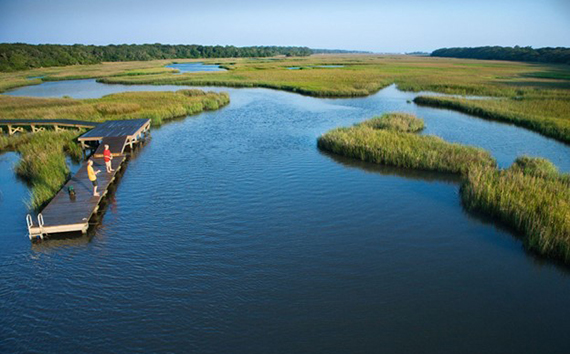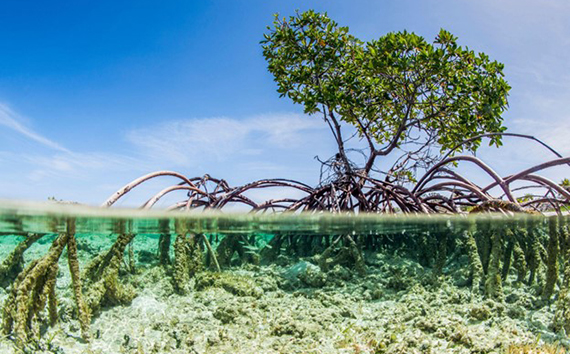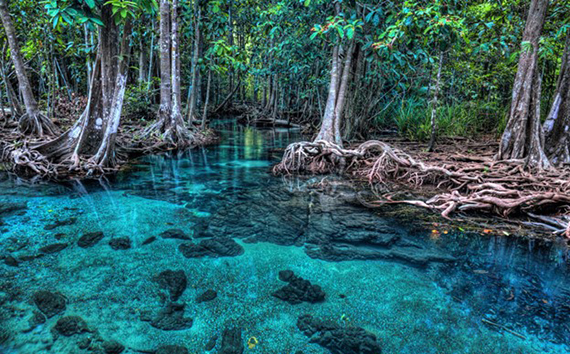Many businesses work hard to cut their emissions as low as they can, but today’s technology or limited resources prevent them from fully reaching net-zero emissions. This is where carbon credits can help.
People, businesses, non-profits, and others purchase these credits, which fund green initiatives, and use them to offset their remaining emissions. But there’s more than one type of carbon credit.
One type that gets overlooked at times is the blue carbon credit, which involves the carbon emissions trapped in the ocean and coastal ecosystems. So, what are blue carbon credits, and how can they help you and the environment? Continue reading to find out.
How Do Blue Carbon Credits Work?
Blue carbon credits work much like other carbon credits that focus on sequestering or removing carbon from the air through renewable energy, reforestation, or preventing deforestation. But instead of focusing on the land, blue carbon credits focus more on the carbon in the ocean and coastal ecosystems.
Blue carbon credits can help offset the carbon in our oceans through coastal wetland, coastline mangrove, tidal marsh, salt marsh, and seagrass meadow restoration projects and new plant-life growth in marine ecosystems. Like carbon credits that focus on inland plant life that sequesters carbon, blue carbon projects look to stop the loss of this helpful plant life or aid the growth of new plant life to help absorb carbon emissions from their ocean habitats and slow climate change.
Like any other carbon credit, an individual or business donates funds to a blue carbon credit program, and the amount they donate helps offset a certain amount of carbon emissions they produce. These carbon credits come in all sizes, ranging from enough to offset a flight to enough to offset remaining corporate emissions after making all the carbon emission reductions a business could.
How Much Are Blue Carbon Credits Worth?
Reducing blue carbon is more systematic than normal carbon reductions, as it’s far more involved than simply planting a tree. This means blue carbon credits are far more expensive than typical carbon credits.
According to S&P Global, mangrove carbon credits from projects in Asia and Central America cost $13 to $35 per metric ton of carbon dioxide (CO2). According to Bloomberg, standard carbon credits average around $7.53 per ton, showing a roughly two- to four-and-a-half-times price difference between the two.
What Are the Two Types of Carbon Credits?

Carbon credits can fall into a wide range of sub-types, but these often flow into two main categories: avoidance and removal. Let’s explore these two main types of carbon credits.
Carbon Avoidance Projects
Carbon avoidance projects are when organizations look to directly reduce their carbon emissions. This can be through things like renewable energy or changing to a green vehicle fleet. Carbon credits related to carbon avoidance projects tend to be on the lower end of the cost scale.
A good example of carbon avoidance is a company installing solar panels to reduce its reliance on a fossil-fuel-powered electricity provider. Another can be a factory installing emission-reducing technology.
No carbon avoidance projects exist in the blue carbon realm because the blue carbon ecosystem is only about carbon absorption.

Carbon Removal Projects
Carbon removal projects focus on removing the existing carbon and future carbon emissions. This can include planting new trees and other carbon-absorbing plants or using technological carbon sinks and carbon storage to capture and store carbon emissions. Carbon removal credits often trade at higher prices because they require greater investment and are in higher demand. This is due to many people viewing them as a more powerful tool for climate change mitigation.
Blue carbon projects fall directly into the carbon removal classification, as they all have to deal with sequestering carbon, whether it’s through preserving wetlands, restoring mangroves, or rejuvenating seagrass meadows.
Is Buying Carbon Credits Greenwashing?
Greenwashing is when a company does things that make it look like it’s protecting the environment more than it actually is. Can buying carbon credits be greenwashing at times? Yes. Are they typically greenwashing? No.
Carbon credits only fall into the greenwashing territory in a few rare instances. The first is when a company or organization prioritizes carbon credits but does nothing to reduce its own emissions. The second is when a company or organization double-counts its carbon credits. The third is when a company invests in non-verified carbon credits.
Greenwashing also exists on a sliding scale, ranging from moderate to severe. In a moderate greenwashing case, the organization may reduce its carbon emissions slightly or not at all, then offset some or all of its emissions with carbon credits. The carbon credits make it look like it’s helping the environment, but the organization has done little to nothing to shrink its carbon footprint.
Severe greenwashing is when a company makes little to no effort to reduce its emissions and purchases some carbon credits to offset a fraction of its emissions. However, these carbon credits are inexpensive and unverified. The organization then touts these credits as “going green” while, in reality, the credits may not be doing any good, and the company continues polluting as it always has.
To avoid greenwashing, companies should invest in high-quality projects on the voluntary carbon market that are verified for additionality and permanence.
Additionality means the climate action the organization is taking would not have happened without the carbon credit funding and is not a part of the usual business function. For example, purchasing a carbon credit from a company vowing to preserve a forest on its property that it never intended to cut down would violate the additionality requirement.
Permanence means the climate action will remain in place for the foreseeable future. For example, purchasing a carbon credit that funds an organization’s plans to plant 10,000 trees on its campus, but the organization cuts the trees down for expansion in a few years violates the permanence requirement.
If any carbon credit fails the additionality or permanence test, purchasing them to offset your carbon emissions is a form of greenwashing.
Where Does the Money Go When You Buy Carbon Credits?

The money you spend to purchase a carbon credit from a carbon market goes directly to the organization that’s performing the carbon-reducing actions. For example, if you purchase a blue carbon credit for carbon sequestration, the money may be funnelled to an organization that’s planting mangrove forests on a nearby coastline. The organization can then use those funds to complete its greenhouse gas (GHG) sequestering project.
However, not all carbon credits are 100% above board. Some will turn around and use the funds they raise to cover their overall overhead — the general expenses needed to run the business. You can avoid this by ensuring you only purchase carbon credits independently verified by organizations such as Verified Carbon Standard or Gold Standard.
These third-party organizations dig deep into every green project funded by carbon credit purchases and ensure they are of the highest quality and meet all the requirements. This type of verification helps add peace of mind that you’re getting the best-quality carbon credits.

Who Is Buying Blue Carbon Credits?
Anyone can purchase credits from the blue carbon market, including businesses, non-profits, and even individuals. Like any carbon credit, these are great options for people concerned with climate change and rising sea levels. Blue carbon credits are especially well-suited for folks concerned about nature conservancy and aquaculture, as these climate solutions directly help in these areas as a co-benefit to their ability to sequester carbon.
How Much Is an Acre of Carbon Credits Worth?
Farmers and landowners can also get in on carbon credit selling, as their land can act as a carbon sink. From farmers growing cover crops and landowners planting trees on their vast acreage, they can absorb a lot of carbon. Some farmers say the going rate per acre is approximately $20. This aligns with typical pricing, as the trading rate per ton of sequestered carbon is $15 to $20, and one acre of land can sequester 0.2 to 1.5 tons of carbon annually.
With the right forestry initiative that creates great tree coverage, an acre of land can absorb five or more tons of CO2 annually, pushing the value upward of $75 to $100.
Who Is the Largest Buyer of Carbon Credit?
The largest carbon credit buyer in the world is a company you may not even be familiar with. As of 2021, it’s the cryptocurrency platform Toucan. This crypto company is responsible for purchasing over one-quarter of the world’s carbon offsets, totalling 17 million tons of CO2 emissions.
However, Toucan wasn’t looking to offset its own carbon emissions. It actually turned the carbon credits into digital tokens its customers could trade. Essentially, it used these credits to create a digital currency with sustainability backing it.
While Toucan had a massive lead over all other companies in buying carbon credits in 2021, many other organizations still purchased plenty, including:
- Delta Airlines: 8.6 million tons
- Shell: 3.9 million tons
- Volkswagen: 3 million tons
- Audi: 2.5 million tons
- Eni: 2 million tons
- Telstra: 1.4 million tons
Terrapass Can Help You Reach Your Climate Goals

Blue carbon credits are excellent ways to expand your ability to offset carbon emissions in a new and exciting way. They allow you to fund conservation projects that help preserve and restore the coastal ecosystems so the mangroves, salt marshes, seagrass meadows, and other oceanic plant life can effectively absorb carbon emissions from the atmosphere and help slow or reverse climate change.
But blue carbon credits are just one of several carbon credits available. Terrapass has a wide range of carbon credits built for specific situations for businesses and individuals. Check out Terrapass’ carbon credits and see how they can help you meet your emission-reduction goals.
Brought to you by terrapass.com
Featured image:
- SEO Powered Content & PR Distribution. Get Amplified Today.
- PlatoAiStream. Web3 Data Intelligence. Knowledge Amplified. Access Here.
- Minting the Future w Adryenn Ashley. Access Here.
- Buy and Sell Shares in PRE-IPO Companies with PREIPO®. Access Here.
- Source: https://terrapass.com/blog/what-are-blue-carbon-credits/
- :has
- :is
- :not
- :where
- ][p
- 000
- 1
- 10
- 200
- 2021
- 420
- 9
- a
- ability
- About
- above
- According
- Act
- Action
- actually
- add
- Adobe
- After
- agriculture
- Aid
- AIR
- Airlines
- Aligns
- All
- allow
- also
- always
- america
- amount
- an
- and
- Annually
- Another
- any
- ARE
- areas
- around
- AS
- asia
- At
- Atmosphere
- auto
- available
- average
- avoid
- backing
- BE
- because
- between
- Bloomberg
- Blue
- board
- built
- business
- businesses
- but
- buy
- Buying
- by
- Campus
- CAN
- capture
- carbon
- carbon credits
- case
- categories
- central
- certain
- Chance
- change
- changing
- classification
- Climate
- climate action
- Climate change
- co2
- COM
- come
- Companies
- company
- complete
- concerned
- continue
- continues
- Corporate
- Cost
- could
- cover
- coverage
- create
- creates
- credit
- Credits
- crops
- crypto
- crypto company
- cryptocurrency
- Currency
- Customers
- Cut
- cuts
- deal
- deep
- Demand
- difference
- DIG
- digital
- digital currency
- digital tokens
- directly
- do
- does
- doing
- donate
- done
- down
- due
- effectively
- effort
- electricity
- emission
- end
- energy
- enough
- ensure
- ensuring
- Environment
- especially
- essentially
- Even
- Every
- example
- excellent
- exciting
- exist
- existing
- exists
- Expand
- expansion
- expenses
- expensive
- explore
- factory
- fails
- Fall
- familiar
- far
- farmers
- few
- Find
- First
- Fishing
- FLEET
- flight
- flow
- Focus
- focusing
- For
- foreseeable
- forest
- form
- fraction
- from
- fully
- function
- fund
- funded
- funding
- funds
- future
- General
- get
- getting
- GHG
- Global
- Go
- Goals
- Goes
- going
- Gold
- Gold Standard
- good
- great
- greater
- Green
- Growing
- Growth
- had
- happened
- Hard
- Have
- help
- helpful
- helping
- helps
- higher
- highest
- How
- However
- HTML
- HTTPS
- if
- image
- in
- include
- Including
- independently
- individual
- individuals
- inexpensive
- Initiative
- initiatives
- installing
- instead
- intended
- into
- Invest
- investment
- Invests
- involved
- island
- IT
- ITS
- jpg
- just
- just one
- kids
- lake
- Land
- landowners
- largest
- Late
- lead
- LEARN
- Life
- like
- Limited
- little
- Look
- look like
- looking
- loss
- Lot
- Low
- Main
- make
- MAKES
- Making
- many
- many people
- massive
- max-width
- May..
- means
- Meet
- million
- mind
- money
- more
- much
- needed
- net-zero
- never
- New
- no
- Non-Profits
- normal
- nothing
- ocean
- oceans
- of
- offset
- often
- on
- ONE
- only
- Options
- or
- organization
- organizations
- Other
- Others
- our
- out
- over
- overall
- own
- panels
- part
- peace
- People
- performing
- Place
- plans
- Planting
- plants
- platform
- plato
- Plato Data Intelligence
- PlatoData
- Plenty
- powerful
- prevent
- preventing
- price
- Prices
- pricing
- produce
- Program
- project
- projects
- property
- protecting
- provider
- purchase
- purchased
- purchases
- purchasing
- Pushing
- quality
- raise
- range
- ranging
- RARE
- Rate
- reach
- reaching
- Reading
- Reality
- realm
- reduce
- related
- reliance
- remain
- remaining
- removal
- removing
- Renewable
- renewable energy
- require
- requirement
- Requirements
- Resources
- responsible
- restore
- restoring
- reverse
- right
- rising
- roughly
- Run
- S&P
- S&P Global
- say
- Scale
- Second
- see
- Selling
- several
- severe
- should
- simply
- situations
- sizes
- sliding
- slow
- So
- solar
- solar panels
- some
- specific
- spend
- split
- standard
- Still
- Stop
- such
- taking
- technological
- Technology
- territory
- test
- than
- that
- The
- the world
- their
- Them
- then
- These
- they
- things
- Third
- third-party
- this
- those
- Through
- times
- to
- today’s
- Tokens
- Ton
- tons
- too
- tool
- trade
- Trading
- tree
- Trees
- TURN
- Turned
- two
- type
- types
- typical
- typically
- upward
- use
- used
- using
- value
- Vast
- vehicle
- Verification
- verified
- View
- viewing
- Water
- Way..
- ways
- What
- when
- whether
- which
- while
- wide
- Wide range
- will
- with
- without
- Work
- world
- world’s
- worth
- would
- years
- yes
- you
- Your
- zephyrnet












